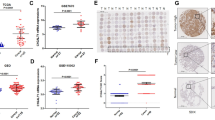Abstract
Recent studies have shown that 14-3-3ζ interacted with other key cellular proteins involved in the tumor development and progression. Knowledge of 14-3-3ζ and β-catenin expression and clinical significance in the same tumor tissues is limited. The purpose of this study was to investigate the expression and significance of 14-3-3ζ and β-catenin in stage I non-small-cell lung cancer (NSCLC). Specimens of NSCLC and adjacent normal lung tissues were collected from 110 patients. The expressions of 14-3-3ζ and β-catenin were detected by western blotting, double labeling immunofluorescence, confocal laser scanning microscopy and immunohistochemistry. The expression of 14-3-3ζ was upregulated in stage I NSCLC. Further, the overexpression of 14-3-3ζ correlated with histological grades, lymph node metastasis and poor clinical outcome. Abnormal expression of β-catenin was significantly correlated with poor differentiation and lymph node metastasis. Abnormal β-catenin expression was associated significantly with positive 14-3-3ζ expression. In conclusion, 14-3-3ζ and β-catenin might have an important role in development, progression and metastatic process of NSCLC. 14-3-3ζ might be used as prognostic biomarkers for NSCLC.






Similar content being viewed by others
References
Granville CA, Dennis PA (2005) An overview of lung cancer genomics and proteomics. Am J Respir Cell Mol Biol 32:169–176
Shankardas J, Senchyna M, Dimitrijevich SD (2008) Presence and distribution of 14–3-3 proteins in human ocular surface tissues. Mol Vis. 14:2604–2615
Kilani RT, Maksymowych WP, Aitken A, Boire G, St-Pierre Y, Li Y (2007) Detection of high levels of 2 specific isoforms of 14–3-3 proteins in synovial fluid from patients with joint inflammation. J Rheumatol 34:1650–1657
Porter GW, Khuri FR, Fu H (2006) Dynamic 14–3-3/client protein interactions integrate survival and apoptotic pathways. Semin Cancer Biol 16:193–202
Li DJ, Deng G, Xiao ZQ, Yao HX, Li C, Peng F (2009) Identificating 14–3-3 sigma as a lymph node metastasis-related protein in human lung squamous carcinoma. Cancer Lett 279:65–73
Yi B, Tan SX, Tang CE, Huang WG, Cheng AL, Li C (2009) Inactivation of 14–3-3 sigma by promoter methylation correlates with metastasis in nasopharyngeal carcinoma. J Cell Biochem 106:858–866
Lee EK, Lee YS, Lee H, Choi CY, Park SH (2009) 14–3-3epsilon protein increases matrix metalloproteinase (MMP)-2 gene expression via p38 MAPK signaling in NIH3T3 fibroblast cells. Exp Mol Med. 41:453–461
Martin D, Brown-Luedi M, Chiquet-Ehrismann R (2003) Tenascin-C signaling through induction of 14–3-3 tau. J Cell Biol 160:171–175
Aitken A (2006) 14–3-3 proteins: A historic overview. Semin Cancer Biol 16:162–172
Matta A, DeSouza LV, Shukla NK, Gupta SD, Ralhan R, Siu KW (2008) Prognostic significance of head-and-neck cancer biomarkers previously discovered and identified using iTRAQ-labeling and multidimensional liquid chromatography-tandem mass spectrome try. J Proteome Res 7:2078–2087
Minamoto H, Antonangelo L, da Silva AG, Gallo CP, e Silva FB, Fenezelian S (2003) Tumour Cell and stromal features in metastatic and non-metastatic non-small cell lung carcinomas. Histopathology 43:427–443
Bienz M (2005) beta-catenin: a pivot between cell adhesion and Wnt signalling. Curr Biol 15:R64–R67
Kikuchi A (2003) Tumor formation by genetic mutations in the components of the Wnt signaling pathway. Cancer Sci. 94:225–229
Keshamouni VG, Michailidis G, Grasso CS, Anthwal S, Strahler JR, Walker A (2006) Differential protein expression profiling by iTRAQ-2DLC-MS/MS of lung cancer cells undergoing epithelial-mesenchymal transition reveals a migratory/invasive phenotype. J Proteome Res 5:1143–1154
Matta A, Bahadur S, Duggal R, Gupta S, D; Ralhan R (2007) Over-expression of 14-3-3ζ is an early event in oral cancer. BMC Cancer 7:169-180
Leinonen T, Pirinen R, Böhm J, Johansson R, Ropponen K, Kosma VM (2006) Expression of matrix metalloproteinases 7 and 9 in non-small cell lung cancer. Relation to clinicopathological factors, beta-catenin and prognosis. Lung Cancer. 51:313–321
Wilker E, Yaffe MB (2004) 14–3-3 Proteins: A focus on cancer and human disease. J Mol Cell Cardiol 37:633–642
van Zeijl MJ, Testerink C, Kijne JW, Wang M (2000) Subcellular differences in post-translational modification of barley 14–3-3 proteins. FEBS Lett. 473:292–296
van Hemert MJ, Niemantsverdriet M, Schmidt T, Backendorf C, Spaink HP (2004) Isoform-specific differences in rapid nucleocytoplasmic shuttling cause distinct subcellular distributions of 14–3-3 sigma and 14–3-3ζ. J Cell Sci 117:1411–1420
Li J, Tewari M, Vidal M, Lee SS (2007) The 14–3-3 protein FTT-2 regulates DAF-16 in Caenorhabditis elegans. Dev Biol 301:82–91
Dai SD, Zhang XW, Qi FJ, Xu HT, Wang EH (2007) Expression of E-cadherin, beta-catenin and p120ctn in the pulmonary sclerosing hemangioma. Lung Cancer. 57:54–59
Takemaru KI, Ohmitsu M, Li FQ (2008) An oncogenic hub: beta-catenin as a molecular target for cancer therapeutics. Handb Exp Pharmacol 186:261–284
Lusting B, Behrens J (2003) The Wnt signaling pathway and its role in tumor development. J Cancer Res Clin Oncol 129:199–221
Fang D, Hawke D, Zheng Y, Xia Y, Meisenhelder J, Nika H (2007) Phosphorylation of beta-catenin by AKT promotes beta-catenin transcriptional activity. J Biol Chem. 282:11221–11229
Tian Q, Feetham MC, Tao WA, He XC, Li L, Aebersold R (2004) Proteomic analysis identifies that 14–3-3ζ interacts with beta-catenin and facilitates its activation by Akt. Proc Natl Acad Sci 101:15370–15375
Li FQ, Mofunanya A, Harris K, Takemaru K (2008) Chibby cooperates with 14–3-3 to regulate β-catenin subcellular distribution and signaling activity. J Cell Biol 181:1141–1154
Conflict of interest statement
The authors declare that we have no conflict of interest related to the publication of this manuscript.
Author information
Authors and Affiliations
Corresponding author
Rights and permissions
About this article
Cite this article
Zang, D., Li, X. & Zhang, L. 14-3-3ζ Overexpression and abnormal β-catenin expression are associated with poor differentiation and progression in stage I non-small cell lung cancer. Clin Exp Med 10, 221–228 (2010). https://doi.org/10.1007/s10238-009-0089-2
Received:
Accepted:
Published:
Issue Date:
DOI: https://doi.org/10.1007/s10238-009-0089-2




